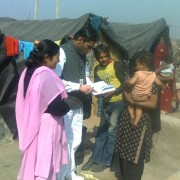Speeches Shim
As the morning sun rays hit the Subukia village in Kenya’s Nakuru County, hundreds rise and leave their homes for daily labor. Living among them is Elizabeth Wangombe Wangui, a 47-year-old dairy farmer.
Even in a computer’s voice, the story being recited loudly over the speakers is so engrossing that 13-year-old Khushiya hasn’t bothered to blink in the last 20 seconds. In a classroom at Vejalpur Primary School in the western Indian state of Gujarat, sit about 30 students with their eyes locked on the monitor displaying the text of a story about a tree and its leaves. English is not their first language but as the computer narrates, the children repeat each word with near perfect pronunciation.

Up until the 1990s, between 500 and 1,000 children on average were paralyzed by polio in India every day. With support from USAID, the CORE Group Polio Project began helping India to eradicate polio in 1999. The project trained community mobilization coordinators to encourage mothers and families to immunize their children against polio.

USAID’s support to the Government of India’s Revised National TB Control Program has led to improvements in TB case detection and treatment success rates, and to achieving national targets in priority geographic areas. Interventions are designed to improve and scale comprehensive HIV/TB services; strengthen and accredit laboratories for diagnosis of multidrug-resistant TB; improve airborne infection control; introduce new diagnostics; and increase involvement of private providers.

Comment
Make a general inquiry or suggest an improvement.